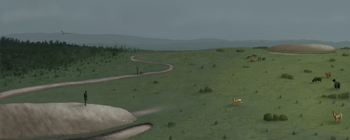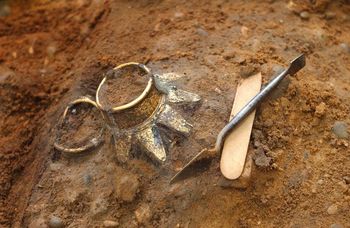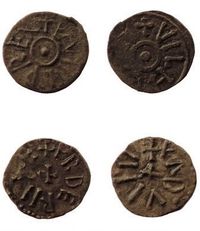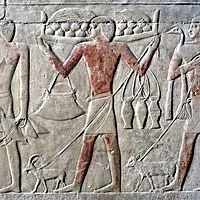Primary education
Prehistory
Resources for learning about changes in Britain from the Stone Age to the Iron Age
Grave goods: objects and death in later prehistoric Britain

This archive includes a dedicated Resources for Schools page containing an information pack and classroom handout designed for teaching prehistory (Stone Age to Iron Age) in primary schools. It focuses on prehistoric burial and the often spectacular or intriguing objects placed with the dead. The pack includes three specially commissioned poems by children’s poet Michael Rosen – inspired by three real prehistoric burials – as well as a series of imaginative reconstruction illustrations. General background information about the Neolithic, Bronze Age and Iron Age across Britain (and burial during those times) is also included.
The Star Carr and Lake Flixton Archive

Star Carr is a Mesolithic (Stone Age) site in the Vale of Pickering, North Yorkshire that is world renowned for the prehistoric artefacts preserved in the peat. Some of the most intriguing artefacts discovered at the site are the antler headdresses, which may have been used when hunting, or by shamans in ritual activities.
The Star Carr and Lake Flixton digital archive contains site records and reports from the excavations, including videos and photographs of the site being excavated and artefacts being found. The Star Carr Archives Project also contains a searchable database of artefacts discovered at the site, including photographs of the antler frontlets. Additionally, there is an Internet Archaeology article with more information on A Unique Engraved Shale Pendant from the Site of Star Carr. More information on Star Carr can be found on the Star Carr Archaeology Project website and its dedicated Schools Pages.
Iron Age Settlement in Wales

This Issue of Internet Archaeology (48) explores Iron Age settlement in Wales. The articles are an ideal resource for educators putting together teaching material on Wales or the United Kingdom in the Iron Age. The issue includes articles on New Perspectives on the Architecture and Function of Welsh Hillforts and Defended Settlements and The Iron Age Today.
Recent Investigations at Two Long Barrows and Reflections on their Context in the Stonehenge World Heritage Site

Recent geophysical surveys and excavations at Druid’s Lodge Estate, in fields west of the Diamond Wood in the Stonehenge World Heritage Site, have confirmed the existence of the Winterbourne Stoke 71 long barrow (chambered tomb) and discovered a new long barrow (Winterbourne Stoke 86) a short distance to the south.
The online article includes an interactive map of the Stonehenge site, linking to simplified plans of long barrows in the study area, additional information and references for further reading for each barrow. The article covers some of the most recent research conducted at the Stonhenge site and is an ideal resource for educators putting together teaching materials on Iron Age Britain or Stone Henge.
Roman Britain

Resources for learning about the Roman Empire and its impact on Britain
A Long Way from Home: Diaspora Communities in Roman Britain
This archive explores the diversity of communities in Roman Britain. It is believed that Britain was home to a wide range of immigrants during the Roman period. The project used scientific techniques to study skeletons to lean more about Roman people and life in Roman Britain.The ADS archive provides references to publications and details on the skulls and teeth examined. A teaching resource for Key Stage 2: Romans Revealed was also created by the project. The website presents four individuals selected from our research (some locals and some incomers) and children can explore them either through ‘digging up’ their graves or through following short stories written by Caroline Lawrence and illustrated by Aaron Watson. A teaching resource pack for teachers provides lesson plans for Key Stage 2 and can be used by children to learn about how diverse Roman Britain was and what the people who lived here during Roman times were really like.
Anglo Saxon and Viking
Resources for learning about Britain’s settlement by Anglo-Saxons and Scots and the Viking and Anglo-Saxon struggle for the Kingdom of England to the time of Edward the Confessor
The Prittlewell princely burial

In 2003, Archaeologists excavating the site of Prittlewell discovered an intact Anglo-Saxon princely burial. The princely burial is a find of international significance – the richest and most important Anglo-Saxon burial found since the 1930s. Images of the Anglo Saxon, Roman and Prehistoric finds can be viewed in the archive, along with an image search of the beautiful artefacts found at the site. There is also an interactive online chamber where the extraordinary stories behind the objects discovered can be explored in more detail on the Prittlewell website.
The Viking Great Army and its Legacy: plotting settlement shift using metal-detected finds

This project was an investigation of the Anglian and Anglo-Scandinavian settlement at Burrow House Farm, Cottam, East Yorkshire from 1993-95 and was a pioneering collaboration between archaeologists and metal-detectorists, and led to the identification of a new form of Anglo-Scandinavian farmstead. It was also one of the first investigations ever undertaken of a ‘productive site’, so-called because of the large quantities of early medieval metalwork recovered by metal-detecting.
Archaeological Evaluation of the Anglo-Saxon and Viking site at Torksey, Lincolnshire

The Anglo-Saxon Chronicle records that, in the winter of 872-3 AD, the Viking Great Army spent winter at Turcesige. Recent archaeological work has revealed the location of the winter camp to be located in the present-day village of Torksey. The ADS archive contains images of metal-detected finds from the winter camp and there is an Open Access publication available as part of the project.
Ancient Egypt and Early Civilisations
Resources for learning about Ancient Egypt and early civilisations
The Virtual Amarna Project

This ‘virtual museum’ contains artefacts from the Egyptian site of Amarna, the ancient city built by the Pharaoh Akhenaten around 1350 BC. Artefacts such as statues, wooden artefacts, spindle whorls, stele and figurines were scanned using a 3D laser scanner and are available in the digital archive. Interactive 3D models of the ancient Egyptian objects can be viewed on the Downloads page, as well as in the Virtual Amarna collection on the University of York Archaeology Department’s Sketchfab page. This is a fantastic resource for students studying the ancient world to explore and interact with Egyptian artefacts at home. The objects were selected to illustrate the theme of personal religion at Amarna, and this would be an excellent resource for Primary School students studying religion in ancient world. The detail of the 3D models and variety of materials they are made from would also make the virtual museum ideal for projects in investigating Ancient Egyptian art and crafting techniques.
Oxford Expedition to Egypt: Scene-details Database

The Egypt Scene-details Database is a simple way of finding information about scenes and scene details preserved on the walls of tombs dating to the ‘Old Kingdom’ or ‘Pyramid Age’ of Ancient Egypt (c. 2650 – 2150 BC). The archive contains illustrations depicting daily life in ancient Egypt. The Database page can be used to search thematically for scenes such as food preparation, funerary rites, medical procedures, agricultural pursuits, and dance, music and games. This archive would be an excellent resource for projects on daily life in ancient Egypt, Egyptian art or for any history themed art projects.



